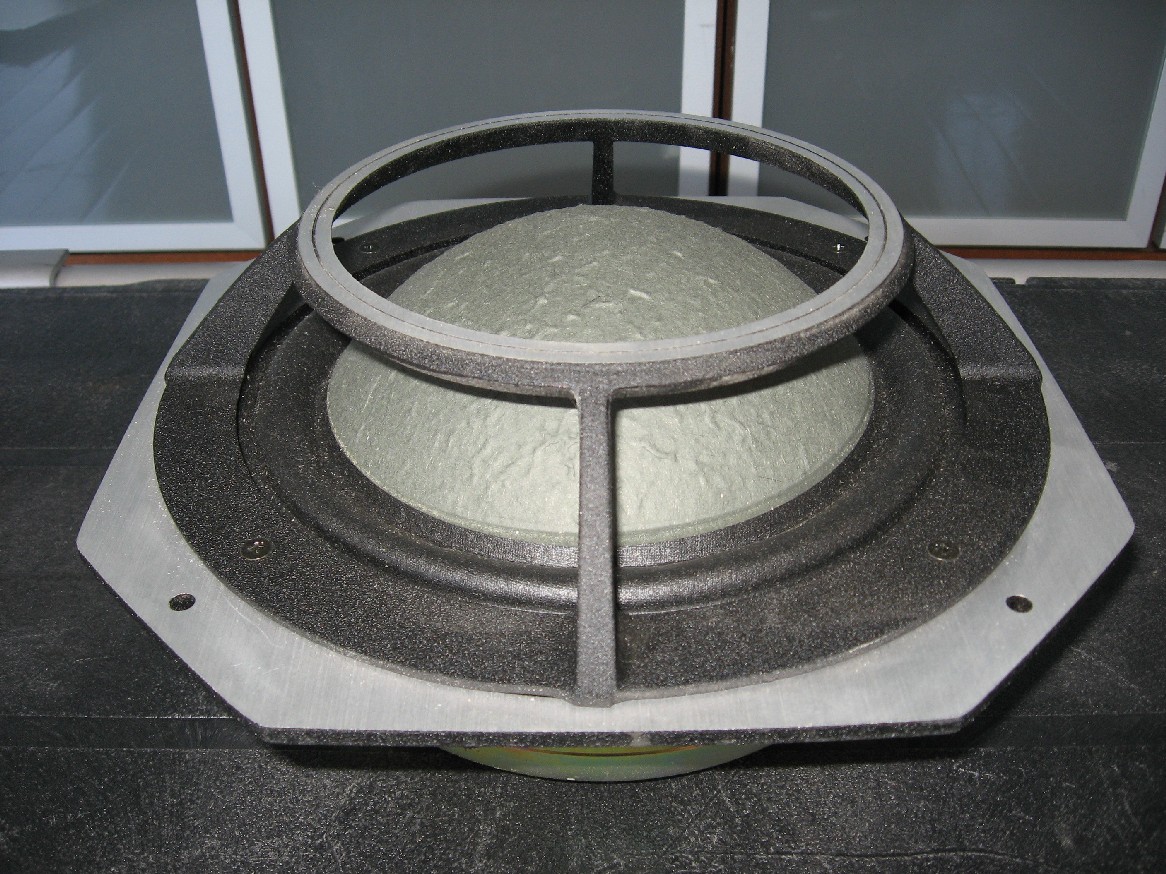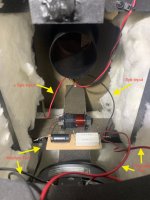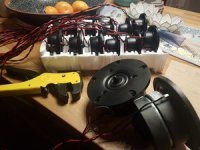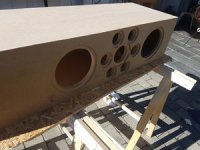Hello all. This is the forum I found for multiway tweeters, in my case, identical ones used as upper midrange tweeters between a 6.5" woofer and a 3" plate tweeter.
I know it's not really a Tekton rig, but am looking for advice.
My plan is 2 six and a half midranges, crossed to each other at 400-600 hertz. Beside them in a vertical line will be five metal dome tweeters. There will be an upper and lower pair series parallel wired to maintain a nominal 6 ohm impedance.
A single tweeter will be between them, also at 6 ohms. I'm thinking of a 2 slope crossover between the tweeters and tweeter-mids at about 4000 hertz, and between the woofers and mid-tweeters at about 1750 .The woofers will likewise be split at 400 to 500 hertz first order.
These will be on a folded try baffle, two 12" x0.75" x46" pieces at 90° with an integral plate acting as a plinth.
Roundovers everywhere, including the back of the woofer cutouts.
These drivers are all pretty flat, about an octave and a half or more above and below the crossover ponuts. I will most likely do a stereo amp per channel, with a bass plate amplifier and an active crossover, to simplify for me volume settings for an already existing bass panel, and the new mains.
In the past, I've futzed around with passive padding to match levels, but I got hurt months ago, and need an easier build.
I am probably choosing this configuration because I like the sound of open baffle, lower Doppler distortion from a split midrange, a line looking array to limit upper midrange dispersion, while extending the tweeter out put a bit lower with less phase damage from a shallower slope.
Too weird, or damn the torpedoes?
I know it's not really a Tekton rig, but am looking for advice.
My plan is 2 six and a half midranges, crossed to each other at 400-600 hertz. Beside them in a vertical line will be five metal dome tweeters. There will be an upper and lower pair series parallel wired to maintain a nominal 6 ohm impedance.
A single tweeter will be between them, also at 6 ohms. I'm thinking of a 2 slope crossover between the tweeters and tweeter-mids at about 4000 hertz, and between the woofers and mid-tweeters at about 1750 .The woofers will likewise be split at 400 to 500 hertz first order.
These will be on a folded try baffle, two 12" x0.75" x46" pieces at 90° with an integral plate acting as a plinth.
Roundovers everywhere, including the back of the woofer cutouts.
These drivers are all pretty flat, about an octave and a half or more above and below the crossover ponuts. I will most likely do a stereo amp per channel, with a bass plate amplifier and an active crossover, to simplify for me volume settings for an already existing bass panel, and the new mains.
In the past, I've futzed around with passive padding to match levels, but I got hurt months ago, and need an easier build.
I am probably choosing this configuration because I like the sound of open baffle, lower Doppler distortion from a split midrange, a line looking array to limit upper midrange dispersion, while extending the tweeter out put a bit lower with less phase damage from a shallower slope.
Too weird, or damn the torpedoes?
Just noticed in the Tekton design youtube videos that the tweeter array goes down to 400 hz in some models and about 200Hz in some models.
Lets try to see the LP of the xover. At the low end all the inductors are shorted, the equivalent resistance of the tweeter array is 5.33 ohms (if each unit is 8 ohms). The xover thus is about 1800Hz, first order, nowhere near 400Hz claimed in the videos.
In case each unit is 4 ohms, the xover freq is even higher. Can somebody explain from where "the tweeter play down to 400Hz" conclusion coming from?
Pure gimmick?
Lets try to see the LP of the xover. At the low end all the inductors are shorted, the equivalent resistance of the tweeter array is 5.33 ohms (if each unit is 8 ohms). The xover thus is about 1800Hz, first order, nowhere near 400Hz claimed in the videos.
In case each unit is 4 ohms, the xover freq is even higher. Can somebody explain from where "the tweeter play down to 400Hz" conclusion coming from?
Pure gimmick?
Last edited:
Bueller? Can someone explain how to the attenuation RC in series (1ohm/8.2uF) is calculated?
When analyzing L,C,R circuits the following helps:
- At high frequencies capacitors (C) are like a short ciruit
- At low frequencies capacitors (C) are like an open ciruit
- At high frequencies inductors (L) are like an open ciruit
- At low frequencies inductors (L) are like a short ciruit
Though this is a Time somebody made a 3" or 5" dome fullrange.
Not quite fullrange, but Peerless are making dome woofers and mids:
GBS Low Profile Woofers & Subwoofers | Peerless by Tymphany
In post twelve, I made a couple of arguments:
1) The six tweeters in a ring are not playing full range, they are low-passed
2) That mess of capacitors in the front of a circuity isn't necessary. You could do this with a simple 2nd order filter. The mess of capacitors is likely to lower cost by using one expensive cap bypassed with an array of inexpensive caps.
To test this hypothesis, I made another model.
This model has a couple of features:
1) the mess of capacitors is replaced with a single cap
2) The ring of six tweeters is replaced with a ring of six midranges
Picture this array, but replace the six tweeters in the outer ring with six midranges instead. The center tweeter remains unchanged.
Here's the results:
The idea is the same. A single tweeter playing full range in the center, surrounded by six more drivers that are low passed. In this case, the drivers are Tymphany TC6 midranges instead of SB29 tweeters. This drops the cost A LOT. Seven tweeters costs over $400, whereas one tweeter and six midranges costs $106. The use of midranges instead of tweeters makes the rolloff of the array shallower. The overall efficiency is a little bit higher. The impedance is a LOT lower; about half as much. So if you did this, you'd have to tweak the crossover to match it to your amp.
Basically the use of midranges instead of tweeters in the ring lowers the cost a great deal, but the efficiency suffers because the tweeters have an efficiency of 87dB while the midranges have an efficiency of 84dB.
If it were me, I'd use midranges in the ring instead of tweeters. The use of tweeters raises the efficiency a tiny bit, but at an enormous cost, basically quadrupling the cost of the array.
So for a budget version, one could use the Tymphany XT25SC90-04 tweeter, surrounded by 6 Tymphany TC6FD02-04 mid/full range drivers.
Ring radiators generally have a wider beamwidth than conventional domes. This comes at the expense of low frequency extension; because a ring has less area than a circle of equivalent diameter, ring radiators generally need a higher xover point.
I'm not saying that ring radiators are BAD, in fact I mostly use ring radiators. But they have some inherent disadvantages.
To make a long story short, you'd want to simulate the array in VituixCad. Basically you'd have to figure out if it's possible to get the midranges close enough. If you're using a big beefy dome tweeter, you can generally get away with center-to-center spacing that's wider. YMMV
I'm not saying that ring radiators are BAD, in fact I mostly use ring radiators. But they have some inherent disadvantages.
To make a long story short, you'd want to simulate the array in VituixCad. Basically you'd have to figure out if it's possible to get the midranges close enough. If you're using a big beefy dome tweeter, you can generally get away with center-to-center spacing that's wider. YMMV
I'm not saying the TC25 is a bad choice, just that ring radiators are tricky in general, because their low frequency extension isn't great.
Having said that, I mostly use ring radiators because if you can deal with their shortcomings, they're BEASTS
For instance, my current fav is the BMS 4526HE. Nobody uses this thing, it's not stocked by Madisound or Parts Express or Meniscus or US Speaker. This $80 tweeter will melt your face with about five watts. Because rings are so small, they can get REALLY LOUD but you have to be careful with the high pass filter to keep from blowing them up.
The 4526HE will hit THX levels with one watt. A $100 Scanspeak tweeter needs TWO HUNDRED watts, but it can handle a much lower xover.
http://www.bmsspeakers.com/fileadmin/bms-data/product_data_2015/bms_4526nd_prelim_datasheet.pdf
Having said that, I mostly use ring radiators because if you can deal with their shortcomings, they're BEASTS
For instance, my current fav is the BMS 4526HE. Nobody uses this thing, it's not stocked by Madisound or Parts Express or Meniscus or US Speaker. This $80 tweeter will melt your face with about five watts. Because rings are so small, they can get REALLY LOUD but you have to be careful with the high pass filter to keep from blowing them up.
The 4526HE will hit THX levels with one watt. A $100 Scanspeak tweeter needs TWO HUNDRED watts, but it can handle a much lower xover.
http://www.bmsspeakers.com/fileadmin/bms-data/product_data_2015/bms_4526nd_prelim_datasheet.pdf
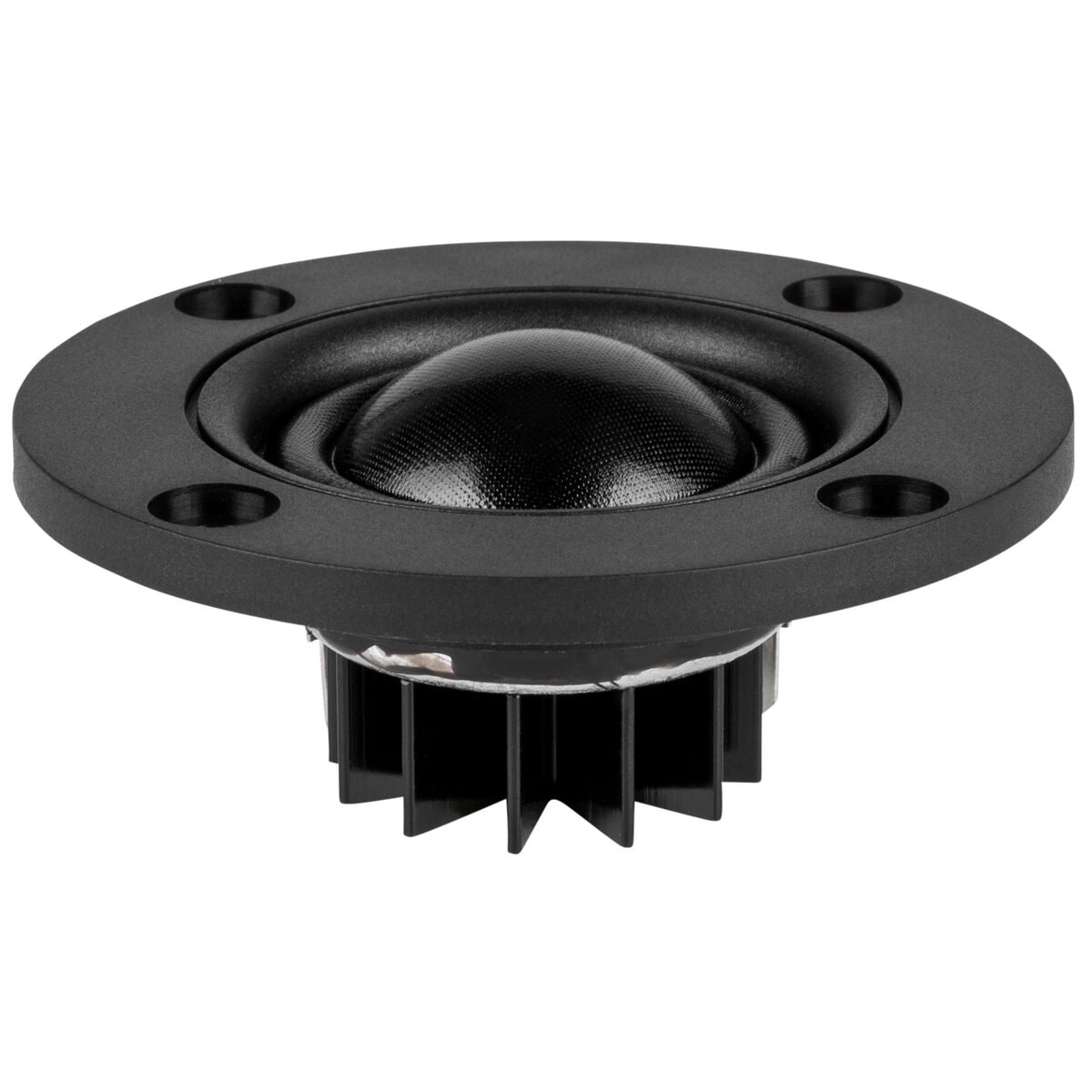
Small bezel (2.6”) gets eveeything closer together, should make for greater coherence.
Just using close as a criteria, similar or less diameter than the above. No comment on quality, and i only looked at the first 4 or 5 pages of the PE catalog, and pasted a few examples.
1” domes
2.75” / Peerless by Tymphany BC25SC06-04 1" Textile Dome Tweeter
Peerless by Tymphany BC25SC08-04 1" Silk Dome Neodymium Tweeter with Waveguide 4 Ohm
1.62’ / no bezel | Peerless by Tymphany OC25SC65-04 1" Textile Dome Tweeter
0.75” domes
1.77” / Dayton Audio ND20FA-6 3/4" Soft Dome Neodymium Tweeter
1.5” / Dayton Audio ND20FB-4 Rear-Mount 3/4" Soft Dome Neodymium Tweeter
1.15” / no bezel, ringdome | https://www.parts-express.com/Peerless-OT19NC00-04-3-4-Fabric-Dome-Tweeter-4-Ohm-264-1122
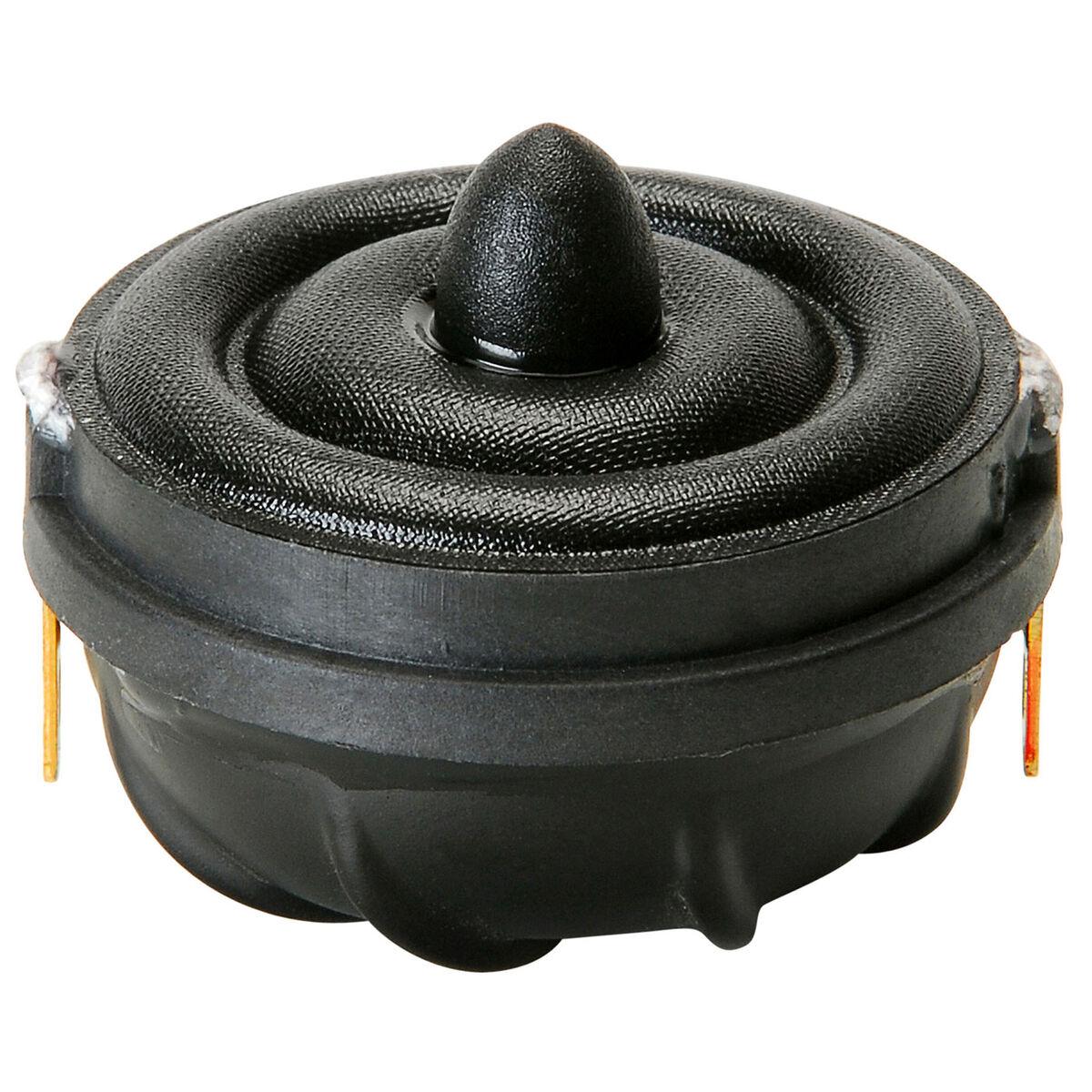
dave
In post twelve, I made a couple of arguments:
1) The six tweeters in a ring are not playing full range, they are low-passed
2) That mess of capacitors in the front of a circuity isn't necessary. You could do this with a simple 2nd order filter. The mess of capacitors is likely to lower cost by using one expensive cap bypassed with an array of inexpensive caps.
To test this hypothesis, I made another model.
This model has a couple of features:
1) the mess of capacitors is replaced with a single cap
2) The ring of six tweeters is replaced with a ring of six midranges
Picture this array, but replace the six tweeters in the outer ring with six midranges instead. The center tweeter remains unchanged.
Here's the results:
The idea is the same. A single tweeter playing full range in the center, surrounded by six more drivers that are low passed. In this case, the drivers are Tymphany TC6 midranges instead of SB29 tweeters. This drops the cost A LOT. Seven tweeters costs over $400, whereas one tweeter and six midranges costs $106. The use of midranges instead of tweeters makes the rolloff of the array shallower. The overall efficiency is a little bit higher. The impedance is a LOT lower; about half as much. So if you did this, you'd have to tweak the crossover to match it to your amp.
Basically the use of midranges instead of tweeters in the ring lowers the cost a great deal, but the efficiency suffers because the tweeters have an efficiency of 87dB while the midranges have an efficiency of 84dB.
If it were me, I'd use midranges in the ring instead of tweeters. The use of tweeters raises the efficiency a tiny bit, but at an enormous cost, basically quadrupling the cost of the array.
Hello Patrick,
I've been reading this post for a couple of days now and I'm convinced that I want to replicate Tekton's Pendagron Monitors.
I already have some items in my shopping cart:
4 Eminence LEGEND BP102-4
12 Tymphany TC6
and I already have 2 pioneer TS-B350PRO that I would like to use for the center tweeters.
I intent to use Gen I Sonicaps for the xover, I can solder the components together and follow the values in post#14. I just need a Sim screenshot for the woofers. I'm not good at using Xsim
I appreciate any help
George
..need help troubleshooting 'low bass level' on Tekton Double Impact Speakers
I purchased a set of Tekton Double Impact Speakers earlier this year. From day one, I noticed that there was not great bass as described in the many positive reviews of the speakers. The bass sound seems very flat, especially at low to normal listening levels. The speakers are connected to a Willensenton R8 Tube Amplifier, Bluesound Node2i Network Streamer, and a Denafrips Ares II DAC. After trying just about everything from new speaker cables, Tidal Subscription, Two sets of Tubes Kt88 & EL34, to moving them out from the wall I decided to take a look inside the speaker by removing the top 10" woofer which allowed me to see the crossover inside. Based on what I see, does anyone know if the wiring to the crossover look ok? Are the wires from the woofers reversed? I see the red pos. wires from the woofers connected to the neg. side of the crossover and the black neg. wires from the woofers connected to the pos. side of the crossover. Could they have been wired incorrectly at the factory? Any help or input that can help would be great appreciated..
I purchased a set of Tekton Double Impact Speakers earlier this year. From day one, I noticed that there was not great bass as described in the many positive reviews of the speakers. The bass sound seems very flat, especially at low to normal listening levels. The speakers are connected to a Willensenton R8 Tube Amplifier, Bluesound Node2i Network Streamer, and a Denafrips Ares II DAC. After trying just about everything from new speaker cables, Tidal Subscription, Two sets of Tubes Kt88 & EL34, to moving them out from the wall I decided to take a look inside the speaker by removing the top 10" woofer which allowed me to see the crossover inside. Based on what I see, does anyone know if the wiring to the crossover look ok? Are the wires from the woofers reversed? I see the red pos. wires from the woofers connected to the neg. side of the crossover and the black neg. wires from the woofers connected to the pos. side of the crossover. Could they have been wired incorrectly at the factory? Any help or input that can help would be great appreciated..
Attachments
Thanks Allen. I would assume the Fs on these tweeters is fairly low? Must be close to 400hz? So, if the array has a pass band from 400hz what would the ideal cut off be? I would also think fairly low because the tweeters furthest away from each other are at least 4” apart or more depending on its size.
So how is Tekton getting these tweeters to play 400hz or lower? I’m looking at a pair of OB 15” for my next build and think this tweeter arrangement might be fun to try with them.
There's no way they're using a 400hz crossover. The tweeters would blow up.
It is normally thought that dome tweeters should not be used near or below their resonance.. but this is not strictly true.
Sure, you have to work with the impedance peak, complement the resonance rolloff, contend with distortion, excursion, power handling etc. etc.
..but if you can for some reason then why not?
Sure, you have to work with the impedance peak, complement the resonance rolloff, contend with distortion, excursion, power handling etc. etc.
..but if you can for some reason then why not?
- Home
- Loudspeakers
- Multi-Way
- Help Understanding Tekton Tweeter Array Schematic?
